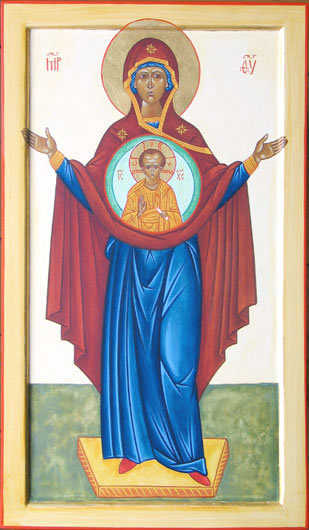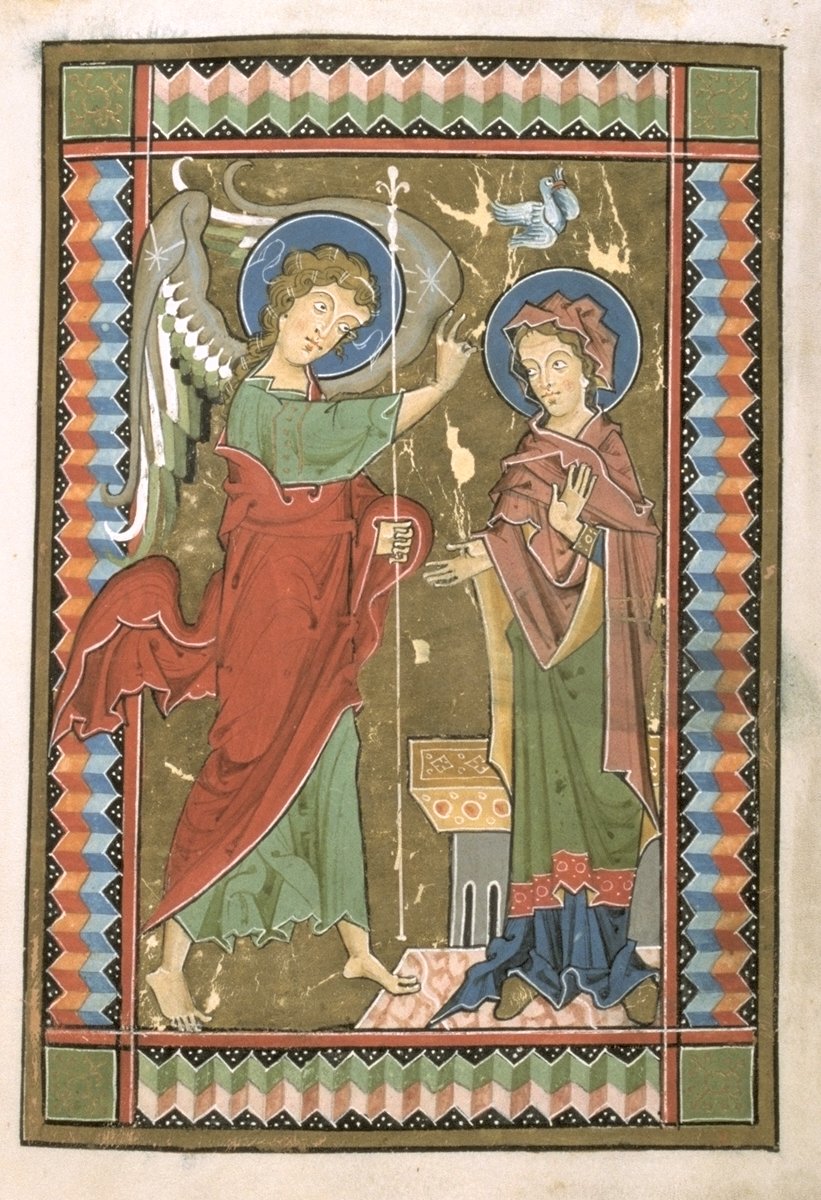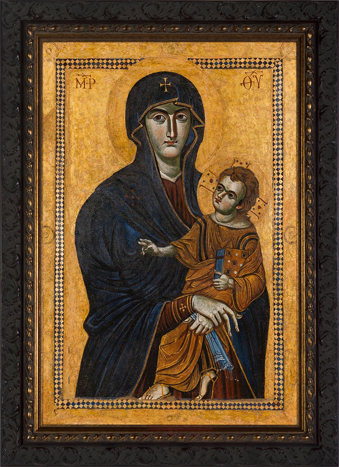 L'icône
de la Mère de Dieu "DU SIGNE DE KOURSK" ("ZNAMINESKAÏA KOURSKAÏA")
trouvée en 1295 et aussi fêtée le 8 septembre, le 27 novembre et le 9ème
vendredi après Pâques. Le 8 mars, on commémore l'échec d'un attentat
contre cette icône, tenté en 1898 par des terroristes dans l'église du
monastère de Koursk où elle était conservée.
L'icône
de la Mère de Dieu "DU SIGNE DE KOURSK" ("ZNAMINESKAÏA KOURSKAÏA")
trouvée en 1295 et aussi fêtée le 8 septembre, le 27 novembre et le 9ème
vendredi après Pâques. Le 8 mars, on commémore l'échec d'un attentat
contre cette icône, tenté en 1898 par des terroristes dans l'église du
monastère de Koursk où elle était conservée.
La tipologia
dell’icona in esame, con la raffigurazione sul suo petto di Cristo Emmanuele
all’interno di un medaglione, è tra le più antiche e svela con particolare
profondità il significato del dogma dell’Incarnazione. La Vergine viene
presentata come il tempio della Chiesa, in cui Dio è presente attraverso il suo
Verbo, secondo il compiersi della promessa fatta al popolo eletto nell’Antico
Testamento; il Bambino prende infatti il nome di Emmanuele dalla profezia di
Isaia (7,14): «Ecco, vi darò un segno: la Vergine concepirà e darà alla luce un
figlio, che si chiamerà Emmanuele, Dio con noi». La simbologia del tempio
bizantino è sottolineata dalla sagoma della figura della Vergine, in cui si
delinea una chiesa cubica coronata da una cupola, entro cui è contenuta il
diskos . I Padri della Chiesa amavano molto questa simbologia, e Massimo il
Confessore esclama: «Colui che l’universo non poteva contenere, è stato
contenuto, o Madre, nel tuo grembo! La Vergine è raffigurata nel gesto dell’orante,
che vediamo già nell’arte tardoantica e nelle catacombe romane, con le braccia
levate al cielo, mentre il Bambino è raffigurato nello stesso atteggiamento
del Pantocratore, con la destra benedicente e il rotolo della legge nella
sinistra. la composizione della Madre di Dio del Segno o dell’Orante compare
sovente anche nei catini absidali delle antiche chiese, ad affresco o in
mosaico).
In questa
icona, la Santa Vergine, è circondata da una cornice dove sono raffigurati i
Santi profeti dell’antico testamento, con cartigli, contenete scritti sulla
prefigurazione di Maria, quale tempio dell’Emmanuele. In Russia uno dei più
antichi prototipi di questa tipologia è l’icona custodita nella cattedrale di
Santa Sofia a Novgorod, del XII secolo, considerata il palladio della città

Variante
della Vergine Orante delle catacombe, lei è simbolo dell’anima
cristiana che loda e adora Dio. Porta sul cuore il medaglione della
gloria che contiene il Figlio radioso. Questo medaglione è il simbolo
della divinità e significa che il “Primo Nato” avanti tutti i secoli ha
abitato il seno verginale di Maria.
La tradizione ha visto in questa
icona un’immagine della profezia di Isaia al tempo del re Acaz che è
l’annuncio velato della nascita del Figlio di Dio : “Pertanto il Signore
stesso vi darà un segno. Ecco: la Vergine concepirà e partorirà un
figlio, che chiamerà Emmanuele.” (Is. VII, 13-14). Il Bambino Gesù,
nell’iconografia , non è mai rappresentato come un neonato, perchè Lui è
già il Verbo; è rivestito con un abbigliamento da adulto e soltanto la
sua dimensione indica che si tratta di un bambino
Madre di Dio "del Segno"
Questa
icona, in cui la Madre di Dio porta in un medaglione sul petto
l'effigie del Salvatore Emmanuele, assume un particolare spessore
dogmatico poiché la Vergine viene definita in relazione alla Sacra
Scrittura: "... il Signore stesso vi darà un segno. Ecco: la vergine
concepirà e partorirà un figlio, che chiamerà Emmanuele" (Is 7, 14).
L'atteggiamento
della Vergine, con le braccia simmetricamente levate al cielo in
preghiera, esprime attesa e disponibilità, e presenta Maria in
un'immagine cardine dell'arte paleocristiana. La Vergine offre
l'Emmanuele. Nel corso della sua vita terrena Cristo non portò mai
questo nome: l'Emmanuele è sempre la raffigurazione del Salvatore prima
dell'Incarnazione, del Logos preesistente al tempo e alla storia, del
Verbo che "è venuto ad abitare in mezzo a noi". In questo modo l'icona
diviene la manifestazione del Dio presente ed incarnato
nell'umanità, che si fa trasparenza, icona a sua volta del mistero
dell'Incarnazione.
Quest'icona dunque non si può assolutamente
leggere come "Vergine col Bambino", in quanto si pone sul piano della
trascendenza assoluta, del simbolo puro, privo di ogni accenno alla
dimensione umana.
Spesso veniva infissa su un'asta per essere
trasportata in processione. (Nei paesi di tradizione bizantina le icone
erano portate anche sui campi di battaglia per sostenere i combattenti).
Generalmente
in questa icona la Madre di Dio è rappresentata a mezzo busto. Quando è
rappresentata a figura intera è chiamata "la Grande Panaghia" ("la
Tuttasanta").
Una variante di questa tipologia è la "Madre di Dio
Orante": Maria, senza il Bambino, tiene le mani alzate in atteggiamento
di preghiera e di supplica.
I colori delle vesti della Madre di Dio sono inversi a quelli del Cristo: la veste è blu e il manto è porpora, di una tonalità
scura. Il colore cupo del manto parla di raccoglimento, di lotta, di sacrificio per affermare ogni valore superiore.
Le tre stelle sul capo e sulle spalle di Maria sono il simbolo della sua Verginità prima, durante e dopo il parto.
Sulle
icone della Madre di Dio, inoltre, scompare del tutto l'antico
appellativo "Santa Maria" per lasciare posto a quello di "Theotòkos",
cioè "Madre di Dio" (MP OY: MHTHP THEOU).
Per gli ortodossi, la
Vergine è sempre e solo la "Madre di Dio", perché non la veneriamo per
se stessa, ma soltanto perché è la Madre del nostro Dio, e ci rivolgiamo
a Lei sempre in relazione al Figlio. Molto raramente, infatti, è
rappresentata da sola, senza il Cristo.





















